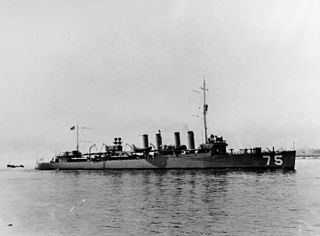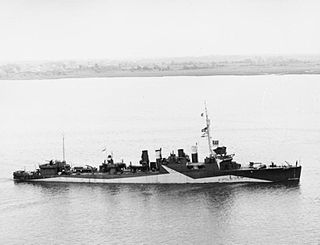
During the early years of World War II before the United States became a formal belligerent, President Franklin D. Roosevelt declared a region of the Atlantic, adjacent to the Americas as the Pan-American Security Zone. Within this zone, United States naval ships escorted convoys bound for Europe. In practice, this greatly aided the United Kingdom, which was largely dependent upon the Atlantic convoys. [1]

World War II, also known as the Second World War, was a global war that lasted from 1939 to 1945. The vast majority of the world's countries—including all the great powers—eventually formed two opposing military alliances: the Allies and the Axis. A state of total war emerged, directly involving more than 100 million people from over 30 countries. The major participants threw their entire economic, industrial, and scientific capabilities behind the war effort, blurring the distinction between civilian and military resources. World War II was the deadliest conflict in human history, marked by 50 to 85 million fatalities, most of whom were civilians in the Soviet Union and China. It included massacres, the genocide of the Holocaust, strategic bombing, premeditated death from starvation and disease, and the only use of nuclear weapons in war.

Franklin Delano Roosevelt, often referred to by his initials FDR, was an American statesman and political leader who served as the 32nd president of the United States from 1933 until his death in 1945. A member of the Democratic party, he won a record four presidential elections and became a central figure in world events during the first half of the 20th century. Roosevelt directed the federal government during most of the Great Depression, implementing his New Deal domestic agenda in response to the worst economic crisis in U.S. history. As a dominant leader of his party, he built the New Deal Coalition, which realigned American politics into the Fifth Party System and defined American liberalism throughout the middle third of the 20th century. His third and fourth terms were dominated by World War II. Roosevelt is widely considered to be one of the most important figures in American history, as well as among the most influential figures of the 20th century. Though he has been subject to substantial criticism, he is generally rated by scholars as one of the three greatest U.S. presidents, along with George Washington and Abraham Lincoln.

A convoy is a group of vehicles, typically motor vehicles or ships, traveling together for mutual support and protection. Often, a convoy is organized with armed defensive support. It may also be used in a non-military sense, for example when driving through remote areas. Arriving at the scene of a major emergency with a well-ordered unit and intact command structure can be another motivation.
The Zone was one of a number of actions taken by the United States that ran counter to its formal state of neutrality. It was set up in October 1939 at US behest by the Declaration of Panama signed by the nations of North and South America. Within the Zone which extended between 300 and 1,000 nautical miles (560 and 1,850 km; 350 and 1,150 mi) offshore, the signatories would not tolerate belligerent acts.

A neutral country is a state which is neutral towards belligerents in a specific war, or holds itself as permanently neutral in all future conflicts. As a type of non-combatant status, neutral nationals enjoy protection under the law of war from belligerent actions, to a greater extent than other non-combatants such as enemy civilians and prisoners of war.

The Organization of American States, or the OAS or OEA, is a continental organization that was founded on 30 April 1948, for the purposes of regional solidarity and cooperation among its member states. Headquartered in the United States capital Washington, D.C., the OAS's members are the 35 independent states of the Americas.
Despite formal complaints in December 1939 to Britain over the action against the Admiral Graf Spee off the River Plate, US implementation of the Zone was clearly to Britain's advantage. From early 1941, United States Navy convoy escorts eased British and Canadian difficulties by providing escorts; USN ships and aircraft were ordered to broadcast in clear any U-boat sightings, thus alerting British listeners. [1] The Kriegsmarine (German navy) resented this "cheating" but they were instructed to avoid hostile acts against US ships so as not to give cause for a declaration of war.

The Battle of the River Plate was the first naval battle in the Second World War and the first one of the Battle of the Atlantic in South American waters. The German panzerschiff Admiral Graf Spee had cruised into the South Atlantic a fortnight before the war began, and had been commerce raiding after receiving appropriate authorisation on 26 September 1939. One of the hunting groups sent by the British Admiralty to search for Graf Spee, comprising three Royal Navy cruisers, HMS Exeter, Ajax and Achilles, found and engaged their quarry off the estuary of the River Plate close to the coast of Uruguay in South America.

The Río de la Plata —rendered River Plate in British English and the Commonwealth and La Plata River in other English-speaking countries—is the estuary formed by the confluence of the Uruguay and the Paraná rivers. It empties into the Atlantic Ocean, forming a funnel-shaped indentation on the southeastern coastline of South America. Depending on the geographer, the Río de la Plata may be considered a river, an estuary, a gulf or a marginal sea. For those who consider it a river, it is the widest river in the world, with a maximum width of about 220 kilometres (140 mi).

The United States Navy (USN) is the naval warfare service branch of the United States Armed Forces and one of the seven uniformed services of the United States. It is the largest and most capable navy in the world and it has been estimated that in terms of tonnage of its active battle fleet alone, it is larger than the next 13 navies combined, which includes 11 U.S. allies or partner nations. with the highest combined battle fleet tonnage and the world's largest aircraft carrier fleet, with eleven in service, and two new carriers under construction. With 319,421 personnel on active duty and 99,616 in the Ready Reserve, the Navy is the third largest of the service branches. It has 282 deployable combat vessels and more than 3,700 operational aircraft as of March 2018, making it the second-largest air force in the world, after the United States Air Force.
On 18 April 1941, Roosevelt extended the Pan-American Security Zone to longitude 26 degrees west, 2,300 nautical miles (4,300 km; 2,600 mi) east of New York and just 50 nautical miles (93 km; 58 mi) short of Iceland, a major convoy staging area.

Longitude, is a geographic coordinate that specifies the east–west position of a point on the Earth's surface, or the surface of a celestial body. It is an angular measurement, usually expressed in degrees and denoted by the Greek letter lambda (λ). Meridians connect points with the same longitude. By convention, one of these, the Prime Meridian, which passes through the Royal Observatory, Greenwich, England, was allocated the position of 0° longitude. The longitude of other places is measured as the angle east or west from the Prime Meridian, ranging from 0° at the Prime Meridian to +180° eastward and −180° westward. Specifically, it is the angle between a plane through the Prime Meridian and a plane through both poles and the location in question.

Iceland is a Nordic island country in the North Atlantic, with a population of 357,050 and an area of 103,000 km2 (40,000 sq mi), making it the most sparsely populated country in Europe. The capital and largest city is Reykjavík, with Reykjavík and the surrounding areas in the southwest of the country being home to over two-thirds of the population. Iceland is volcanically and geologically active. The interior consists of a plateau characterised by sand and lava fields, mountains, and glaciers, and many glacial rivers flow to the sea through the lowlands. Iceland is warmed by the Gulf Stream and has a temperate climate, despite a high latitude just outside the Arctic Circle. Its high latitude and marine influence keep summers chilly, with most of the archipelago having a tundra climate.
Original text of the Panama Declaration and associated documents (including map) can be found at the following link: http://digital.library.wisc.edu/1711.dl/FRUS.FRUS1939v05. Original source: United States Department of State, Foreign Relations of the United States diplomatic papers, 1939, volume V, The American Republics, (Washington, DC: Government Printing Office, 1939), pp. 34-39
















